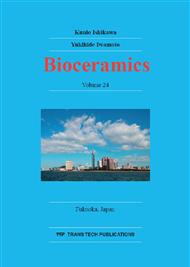p.465
p.471
p.475
p.480
p.486
p.490
p.495
p.501
p.507
Preparation of Calcium Phosphate – Peptide Composites with Highly pH-Sensitive Drug Release
Abstract:
Calcium phosphate (CaP) material has been used successfully for protein delivery. In the present work, our aim is the preparation of CaP combined with peptide and protein, and is the evaluation of pH-sensitive drug release ability. Protein used as the model drug was fluorescein isothiocyanate-bovine serum albumin (FITC-BSA). All compounds synthesized were low crystalline hydroxyapatite (HAp). The result of zeta potential indicated that incorporation of peptide in HAp could be changed the surface charge of particle. The CaP-BSA and CaP-BSA-pLys [Poly-L-lysine (pLys) was added to CaP composite.] were-23.1 mV and-12.0 mV, respectively. The ratio of protein release and dissolved Ca ion were measured by soaking CaP-peptide composites under various pH (pH 7.4, pH 6 and pH 5) conditions. BSA was released from CaP-BSA-pLys at only pH 5, not at pH 7.4 and pH 6.
Info:
Periodical:
Pages:
486-489
Citation:
Online since:
November 2012
Authors:
Keywords:
Price:
Сopyright:
© 2013 Trans Tech Publications Ltd. All Rights Reserved
Share:
Citation:


